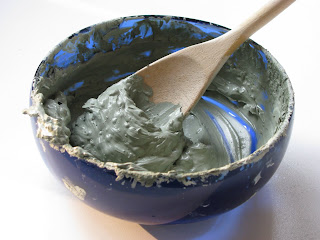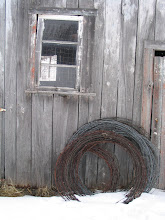Friday, June 17, 2011
The Benefits of Green Clay
I've been fighting a reaction to a topical Betadine ointment that I put on the wound when I chafed my leg.
Turns out I'm allergic to Betadine - and sadly it's taken me a whole 2 weeks to figure this out - whippersnapper that I am. In the interim, my chafed sore is an infected mess, and I'm busy intermittently kicking myself for not figuring this out earlier, and for not using a green clay poultice sooner.
Eric loves his Betadine, so much so that when he goes to France, he makes a point of picking up a few tubes. It's sort of a cure-all for him, and as it turns out, not so much for me. According to my Google-fu, many people are allergic to Betadine, and sadly most of these people only discover their allergy post-op, as Betadine seems to be an antiseptic of choice during surgery.
Anyhow, I have a point I'm trying to get to: why and how to make a green clay poultice.
Now most of you are wondering what a poultice is, and think it's something you do to a horse. Well, it happens that green clay has incredible healing properties, and hindsight being what it is, I probably should have used this first on my abrasion, rather than the Betadine ointment.
But here I am, lying on the sofa, with a green clay poultice wrapped around my ankle, laptop precariously perched on my knees. And I feel better already.
Eric, as you may know, is french. As in - from France - french. He's been extolling the virtues of green clay to everyone who will listen, and it didn't take me very long to be a convert.
We use green clay imported from France. It's readily available in most pharmacies and health-food stores here in Quebec, and the brand we see most often is Cattier:
This type of green clay is a mix of illite and montmorillonite green clay. Both are renowned for their purifying and healing minerals, and let me tell you this little medical nugget: it works. It works wonders on burns, on cuts, on sprains and on infections. We've used it on Cooper when he had an abscess and my dad's used it on gout. The next day, my dad reported he had a huge water-filled blister and his gout healed much quicker than without the poultice.
As far as I know, Cooper didn't complain either.
I could extoll the virtues of green clay ad nauseum. If this stuff could be patented, you'd see big pharma make big bucks. But there's no appeal here, no money to be made, so unless you hear about it through the proverbial grape-vine, you'd never know green clay existed. One interesting article here touts the benefits of green clay in treating buruli, a flesh-eating bacteria. Interesting, indeed.
So next time you have an infection, and you're open enough to "alternative" healing methods, give a green clay poultice a try. Here's how:
Procure yourself some green clay. Google it, do what you need to do to get this stuff in your medicine cabinet! Maybe your local pharmacy even has it - ours does, but then again, this is Quebec. We're like France's favorite cousin. Buy a 50-pound bag from Amazon.com and share with your friends! I really, really hope you can lay your hands on this stuff, because it's great.
Mix with water (Perrier, anyone?) in a glass bowl and let stand at least 30 minutes. Do not use metal bowls or metal utensils - that's bad juju. Add enough water to make a smooth paste - you don't want a runny, sloppy mess. When you place the green clay on a paper towel, you want it to hold its shape:
Yummm. Looks good enough to eat - and it is! If you're really into the granola lifestyle, you can buy comestible clay. It's finely ground, and you add it to water, let it decant overnight, and chug-a-lug the next morning. If you're the turbo-charged granola type, well, leave it in the sun to "re-energize" and then chug-a-lug. I've never tried it, but I am tempted. I have given it to the cats and dog, though. They like clay, it's in their DNA.
Here's where things get good. Slap this baby onto your bobo, (that's french medical-ese for an owie), and grab a bandage and wrap up the offending body part. Go lie on the sofa and make Eric bring you things like ice cream and your Therapik and your laptop and the phone and let the cat in and out and in and out, while he's up.
Just kidding, you can actually do stuff with a poultice on, within limits of course. What I'm obsessed with is how I managed to get my leg up on the kitchen counter, twist my foot at a heretofore inhuman manner, and take a photo. How the hell did I manage that without dislocating a hip? Seriously...? Inquiring minds want to know!
Ah-ha! Here's a better view! I'm not as double-jointed as I knew I wasn't. Or something like that. Grab a lemonade and head for the couch. Act like Cleopatra on her chaise longue and demand bunches of grapes while petting your ancient cat. Trust me, you'll feel better in the morning.
You can keep the green clay on for a few hours, or even overnight. You don't want to let the clay dry on your skin. If it does, use lots of water to soak the poultice off. For dog's sake, don't rip it off, especially if you've put it on an open sore, like I've done. I'll probably wake up at some point tonight and pull it off. What's interesting is that an air bubble will have formed in the shape of the sore - that's so cool. It goes to show that the clay is absorbing something, doing something, healing something, somehow. I wish someone could research this mechanism because it would be cool to find out what exactly is happening.
After you've removed the poultice - toss it. It's not good for anything, anymore. If you have any left unused, simply let it dry and reuse again. It will take longer than a half an hour to soften but it's not a loss.
And another neat thing about the clay - it might be messy, depending on how talented (or not) you are with it. I promise you, this type of green clay will NOT stain anything. It will simply rub off or wash off, depending on the surface, without leaving any stain. I was skeptical at first, but it's true - I have a fetish for white sheets, so I balked at this when Eric told me, but I swear that any dried-on clay can be rubbed off, and then completely washed out.
So I'm off to bed. Green clay poultice and all. See you in the morning.
Labels:
alternative healing,
cattier,
green clay,
healing,
illlite,
infection,
montmorillonite
Subscribe to:
Post Comments (Atom)








6 comments:
Hi, in Italy I have a big problem of fly...it brings my sheep and horses scratching to blood (sorry for my english). Do you think green clay can help us? In these years we try everything (even char coal and salicylic acid a cure straight from a shepherd) Do we need to cover treated part?
Thank you for you attention
Valentina
Hi Valentina, that is a very interesting question! I know from my horse-friends that their horses are drawn to mud when they have an ailment. If you can easily purchase green clay in Italy, why not try it? It would be best if you could cover the treated part with a bandage, but I know that might not be possible, depending on what part you are treating. What types of flies do you have? We have many deer and horse flies.
I found this document on-line:
http://pubs.cas.psu.edu/FreePubs/PDFs/XF0277.pdf
Maybe it can be helpful to you!
Thank-you for your virtual visit!
Ciao,
Ann
Hi Ann,
We have some insects blood sucking: flies during day and some very little mosquitos in night.
I hope this green clay can help us! But I find just something for cosmetic use: solum fullonum.
Might I boil it? I suppose it is not sterilized.
your blog sometimes seems like mine, i like to read it!
thank you for your fast reply.
Valentina
Hi again Valentina - if I understand correctly, solum fullonum is what we call Fuller's earth. Do you know the country of origin of this product? From what I have read, most of it is mined in the US. I believe you'd be best to try and find a local clay. Maybe ask at your pharmacy? I don't see why (or how!) you'd need to sterilize the clay, just mix with room-temperature water and apply it on the sores. Maybe you can make a thinner mixture to sort of paint on, depending on how big an area you need to cover? I don't see that you'd have anything to lose by trying...let me know how things turn out.
Take care,
Ann
Hi Ann,
When I read your post about first hurting your leg I immediately thought about Tea Tee Oil. I use a body lotion with it and use it as a moisturiser and for cuts, scrapes, bruises etc.
Then when I read about you using green clay I looked on the internet and there are quite a few products that use the two ingredients together!
I can't tea tree oil highly enough although the smell is not to everyone's liking.
What I would like to know now - how is the injury after the green clay poultice?
Hope it gets better soon!
D
Hi Demelza!
Thanks for your input. It's getting better with the green clay, but it's still a mess. I have a bottle of tea-tree oil, and until you mentioned it, I didn't think about using it. I'll put it on before I put the clay on tonight, and we'll see how things look tomorrow morning. I really should have started with the clay right when it happened, and not wait like I did. Live and learn, I guess. I'll keep you posted.
Regards,
Ann
Post a Comment